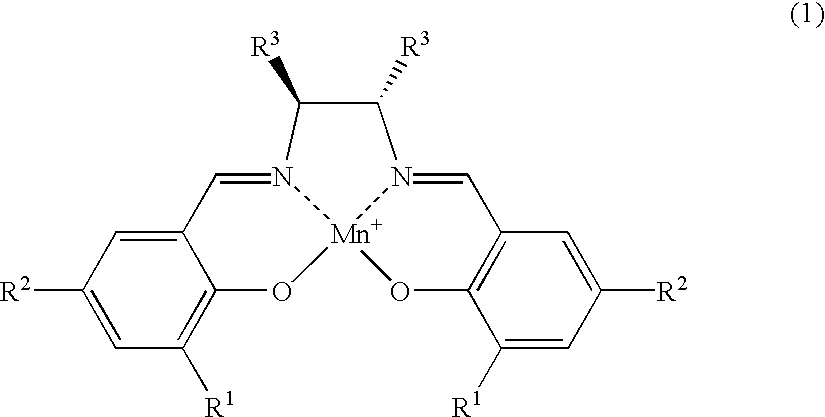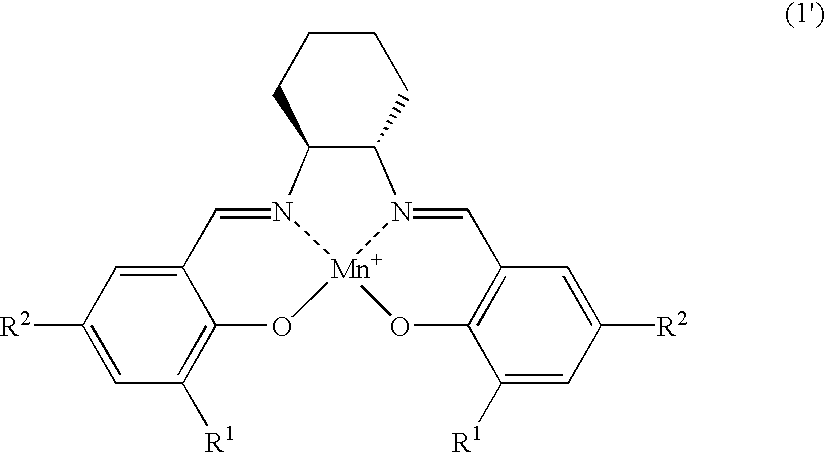Process for preparing amino compounds by using salen-manganese complexes as the catalyst
a technology of salenmanganese and complexes, which is applied in the preparation of amino compounds, organic compounds/hydrides/coordination complexes, physical/chemical process catalysts, etc., can solve the problem that the reactions applicable to the amination of c-h bonds are actually very few
- Summary
- Abstract
- Description
- Claims
- Application Information
AI Technical Summary
Benefits of technology
Problems solved by technology
Method used
Image
Examples
example 1
Amination of Indan
The amination was carried out for the C--H bond at the benzyl position of indan as the starting material, in accordance with reaction formula (8): ##STR7##
The salen-manganese complexes used as the catalyst are shown in FIG. 1. The amount of catalyst used was 6 mol %. The amination agent was (p-toluenesulfonyl) iminophenyliodinane and the reaction was carried out in CH.sub.2 Cl.sub.2 solvent at a reaction temperature of 5.degree. C. in the presence of a molecular sieve (MS-4A) as the dehydrating agent. The results are shown Table 1.
As can be seen from Table 1, the catalytic activity was relatively low (Run No. 8) where there was used a salen-manganese complex in which the positions of R.sup.1 and R.sup.2 were not substituted (ent-7). In the case where a salen-manganese complex was used in which the positions of R.sup.1 and R.sup.2 were substituted with a halogen atom, an electron-withdrawing atom, both the catalytic activity and the enantioselectivity were enhanced ...
example 2
Study on Solvent and Reaction Temperature
The amination reaction of indan was carried out in a similar manner as in Example 1, with varying types of solvent and reaction temperature, by using salen-manganese complex No. 3 as shown in FIG. 1 as the catalyst. The results are shown in Table 2.
As can be seen from in Table 2, the reaction was slow where acetonitrile, ethyl acetate, acetone or toluene was used as the solvent (Run Nos. 2 through 5). In general the reaction proceeded smoothly in the case where a halogen-containing solvent was used (Run Nos. 1, and 6 through 9), and the best result was obtained for the yield and the enantioselectivity when 1,1,2,2-tetrachloroethane was used as the catalyst (Run No. 9). The lowering of the reaction temperature resulted in an improvement in the enantioselectivity without decrease in the yield (Run Nos. 9 through 11), where the best enantioselectivity reached as high as 66% of ee at -40.degree. C.
example 3
Aminations of Various Compounds
The amination reaction was carried out with cyclohexene, tetralin, 1,1-dimethyltetralin or 1,1-dimethylindane as the starting alkene or alkylarene. The catalyst was salen-manganese complex No. 3 as shown in FIG. 1. The reaction was conducted for 24 hours at -40.degree. C. using 1,1,2,2-tetrachlorethane as the solvent. The results are shown in Table 3.
In the case of cyclohexene, 1-[N-(p-toluenesulfonyl) amino] cyclohex-2-ene was produced with an ee of 67% and no aziridine derivative was detected. In the amination of cycloheptene, 1-[N-(p-toluenesulfonyl) amino] cyclohept-2-en was produced with an ee of 41% together with a small amount of aziridine derivative (the aminated product: the aziridinated product=4.8:1). The amination reactions at the benzyl positions of tetralin and 1,1-dimethyltetralin were good, with an enantioselectivity of 77% and ee of 82%, respectively. The enantioselectivity of 1,1-dimethylindan was outstandingly high: ee of 89%.
PUM
| Property | Measurement | Unit |
|---|---|---|
| temperature | aaaaa | aaaaa |
| temperature | aaaaa | aaaaa |
| optically active | aaaaa | aaaaa |
Abstract
Description
Claims
Application Information
 Login to View More
Login to View More - R&D
- Intellectual Property
- Life Sciences
- Materials
- Tech Scout
- Unparalleled Data Quality
- Higher Quality Content
- 60% Fewer Hallucinations
Browse by: Latest US Patents, China's latest patents, Technical Efficacy Thesaurus, Application Domain, Technology Topic, Popular Technical Reports.
© 2025 PatSnap. All rights reserved.Legal|Privacy policy|Modern Slavery Act Transparency Statement|Sitemap|About US| Contact US: help@patsnap.com



